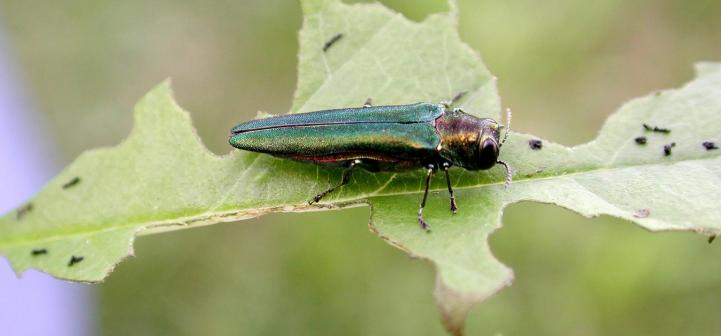Invasive Species: Potentilla recta, Sulphur Cinquefoil
Sulphur cinquefoil is an invasive perennial herb that can grow to 19.7 in. (50 cm) tall. A loose rosette of long-petiolate leaves develops first and withers before flowering. Plants can be one- or multi-stemmed. Stems are covered with long and short hairs and are unbranched (branched only in the inflorescence). Cauline (stem) leaves are palmately compound (with five to seven leaflets), stipulate, and short petioled to sessile. The central leaflet is 1.2 to 5.9 in. (3 to 15 cm) long (longer than the other leaflets). Flowering occurs from May to July, when sulfur yellow flowers develop in open, flat-topped inflorescences at the apex of the stems. Flowers have five petals, each 0.2 to 0.4 in. (6 to 9 mm) long, and 25 to 30 stamens. Fruits are small, dark brown achenes with pale veins. Sulphur cinquefoil is native to Europe and occurs in pastures, rangelands, along roadsides, and other disturbed sites.
What are invasive species and why should we be concerned about them?
Taxonomy: Scientific and Common Names for This Species
Rosales > Rosaceae > Potentilla recta L.
Synonym(s): roughfruit cinquefoil
Potentilla recta – USDA PLANTS Profile
Distribution Maps
Sulphur cinquefoil – The reported distribution of this invasive species across the United States (Source: Invasive Plant Atlas of the United States)
Up-to-the-minute distribution maps and why they are important
Reporting This Invasive Species
What is the best way and place to report the occurrence of an invasive species?
How to report an invasive species sighting to EDDMapS – Early Detection & Distribution Mapping System
EDDMapS – Report an invasive species to EDDMapS.
Cooperative Extension Offices – Find your local Cooperative Extension office on this map provided by USDA.
How to Identify
This invasive species can be identified by looking for the characteristics described in the paragraphs that follow.
Plant
Sulphur cinquefoil is a perennial herb that can grow to 19.7 in. (50 cm) tall. A loose rosette of long-petiolate leaves develops first and withers before flowering. Plants can be one- or multi-stemmed. Stems are covered with long and short hairs and are unbranched (branched only in the inflorescence).
 |
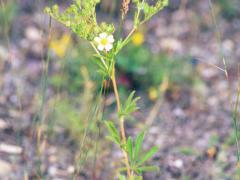 |
| USDA Agricultural Research Service Archive,USDA Agricultural Research Service, bugwood.org | Steve Dewey, Utah State University, bugwood.org |
Foliage
Cauline (stem) leaves are palmately compound (with five to seven leaflets), stipulate, and short petioled to sessile. The central leaflet is 1.2 to 5.9 in. (3 to 15 cm) long (longer than the other leaflets).
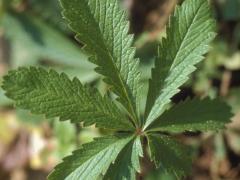 |
 |
| Ohio State Weed Lab Archive, Ohio State University, bugwood.org | Joseph M. DiTomaso, University of California-Davis, bugwood.org |
Flower
Flowering occurs from May to July, when sulfur yellow flowers develop in open, flat-topped inflorescences at the apex of the stems. Flowers have five petals, each 0.2 to 0.4 in. (6 to 9 mm) long, and 25 to 30 stamens.
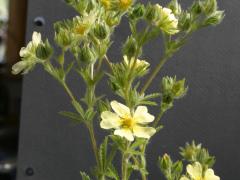 |
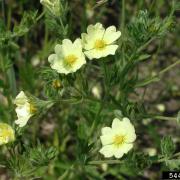 |
| Montana Staewide Noxious Weed Awareness and Education Program Archive, Montana State University, bugwood.org |
Leslie J. Mehrhoff University of Connecticut, bugwood.org |
Fruit
Fruits are small, dark brown achenes with pale veins.
 |
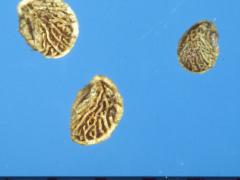 |
| Ken Chamberlain, Ohio State University, bugwood.org | Ken Chamberlain, Ohio State University, bugwood.org |
Native Species That Can Resemble Sulphur Cinquefoil
Potentilla arguta, white cinquefoil – Images at invasive.org
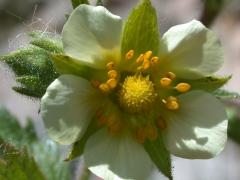 |
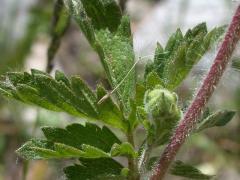 |
| Mary Ellen (Mel) Harte, bugwood.org | Mary Ellen (Mel) Harte, bugwood.org |
Potentilla gracilis, slender cinquefoil – Images at invasive.org
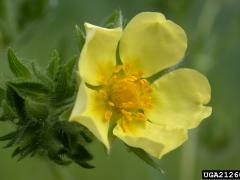 |
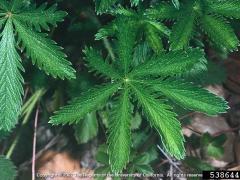 |
| Mary Ellen (Mel) Harte, bugwood.org | Joseph M. DiTomaso, University of California-Davis, bugwood.org |
Additional Images for Sulphur Cinquefoil
Sulphur cinquefoil – Images at Invasive.org
Additional Information, Biology, Control and Management Resources
Control and management recommendations vary according to individual circumstances. Location, habitat, weather, and a variety of other conditions are factors that help determine the best treatment choice. To find the safest and most effective treatment for your situation, consult your state’s land-grant institution. If you will use chemicals as part of the control process, always refer to the product label.
United States Land-Grant University System – Find your land-grant university’s college of agriculture, Cooperative Extension office, or other related partner on this map provided by USDA.
Element Stewardship Abstract – The Nature Conservancy
Fire Effects Information System – USDA Forest Service
Sulphur cinquefoil – Missouriplants.com
Noxious Weed Control – ODA Plant Division
Alaska Natural Heritage Program – University of Alaska Anchorage
